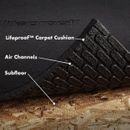Carpet on a Basement Floor
I am considering replacing carpet in my basement. It is dry, there is a radon system in place pulling air from under the slab which is 40 years old (no vapor barrier underneath). There is a dehumidifier permanently installed to control humidity. I am well aware that a flood will ruin the carpet but will take that risk for the comfort it provides. I am considering the life proof waterproof premium plus carpet pad which seems to be a good option to prevent downward transmission of vapor to prevent condensation on the slab. The product is waterproof so as to not hold onto bulk water. There are air channels underneath which would make it work like many of the dimple mats. It seems this would be preferable to the pads that are ust spill resistant but would not allow for saying. Any thoughts on this and if there would be a benefit of using an epoxy or redguard on the slab to prevent upward movement of vapor from slab vs leaving untreated.
GBA Detail Library
A collection of one thousand construction details organized by climate and house part










Replies
Steven,
Finished basement flooring is one of the most difficult assemblies to predict the performance of. Both an upgraded underlayment, and possibly adding a sealant to the slab will make it better than if you didn't. However neither will do much if there is any significant moisture infiltration. So unfortunately, whether this is enough is next to impossible to know.
You might want to consider carpet squares here. Carpet squares are easier to remove/replace if you have problems compared to the usual roll-type carpet that goes down as one huge piece. If you put carpet squares over something like dricore subfloor tiles, you're probably about as safe as you can be for moisture aside from an all out flood.
My personal preference in basements is to use something that really is impervious to moisture. This means things like epoxy (my favorite), or some type of tile or rubber flooring.
Bill
Outside of actual water intrusion, can you do poly+pad+carpet without a subfloor? I have height restrictions and trying to keep flooring height at a minimum. Planning on doing a chloride test.
Yes you can, but you're at much higher risk of mositure problems without a subfloor.
Bill
Moisture from the slab, or humidity in the basement in general?
"There are air channels underneath which would make it work like many of the dimple mats. "
I really, really don't like a lot of the dimple mats because they are sold under blatantly false pretense. Dimple mats have a purpose. If you have liquid water intrusion, you have to give that water some place to go to, and dimple mats allow you to have a waterproof layer that doesn't block the free flow of liquid water, that's what the dimples are for.
But a lot of the advertising materials promote the idea that the purpose of the dimples is to allow air to circulate. That doesn't happen to a meaningful extent, and if it did, it would be a bad thing and not a good thing. If there is moisture in your slab you want to keep it in the slab, where it can't do any harm, and not let it into your living space. The last thing you want is the slab drying to the interior, that's why damp-proofing, vapor barriers and capillary breaks are so important.